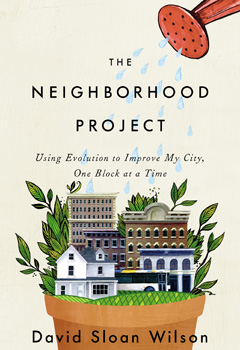 The Neighborhood Project: Using Evolution to Improve My City, One Block at a Time
The Neighborhood Project: Using Evolution to Improve My City, One Block at a Time
by David Sloan Wilson
Little Brown (2011), $25.99
In David Sloan Wilson’s fifth book, the evolutionary biologist chronicles his attempt to use Darwin’s theory of evolution to improve the quality of life in his town of Binghamton, N.Y. It’s an ambitious goal, especially since the concept is a bit vague and obscure. What do Darwin and evolution have to do with the well-being of cities and individuals?
From the title and cover art, it might seem that The Neighborhood Project focuses on programs like urban gardens, litter prevention and neighborhood watches. Instead, it takes it a step further: It’s a serious look at how social problems arise and how understanding the evolution of these problems can provide the keys to best solve them. Public policy, Wilson believes, should be strongly rooted in evolutionary theory.
While The Neighborhood Project isn’t difficult to read or comprehend, it is dense: After all, neighborhoods and people are vibrant, complex and dynamic. With enthusiasm and optimism, Wilson jumps between topics such as religion, economics, education and ecological diversity, dropping in parables about wasps, vignettes of scientists’ childhoods, and histories of Judaism and Ayn Rand’s Objectivism.
In addition to broad evolutionary theory, The Neighborhood Project serves as a memoir of Wilson’s ongoing work with the Binghamton Neighborhood Project (BNP). Loosely characterized as a group of faculty and students using science to make the community a better place, the BNP takes on many roles, locally and globally. Wilson narrates how they used survey data to create a topographical map of Binghamton that reflects varying values of altruism, trust, social support and income. By viewing the city as a living organism and tracking rates of change in behaviors such as smoking, obesity and breastfeeding, he hopes to create interdisciplinary tools that can improve the human condition. While the book isn’t a blueprint to fix social maladies, it is an introduction to a promising new way of viewing individuals and societies.
– Katherine Silkaitis



